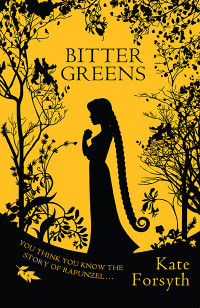I knew the story would change as I told it
 Bitter Greens
Bitter Greens
by Kate Forsyth
This book has a lot of elements that appealed to me: a dark retelling of Rapunzel, a fictionalised account of the writer of the version of Rapunzel most of us know – Charlotte-Rose de la Force – and the story of a 16th century courtesan in Venice who was muse to the great artist Titian. Plus that absolutely gorgeous cover art. How could I resist?
Did it live up to expectations? Yes and no. About a quarter of the way through, I was a little bored and even considered stopping reading. But from about halfway until the end, I was gripped and thoroughly enjoying the ride. So what was the difference?
The bulk of the start of the book is about Charlotte-Rose, but the interesting bits of her story are saved for later on – and it does get very interesting. The book’s opening tells us that she has been banished from the Versailles court of her cousin Louis XIV and been sent to live in a convent as punishment for her behaviour. There are lots of details of how austere and rule-filled the convent is, and flashbacks to court to reveal how wide the contrast is.
It felt like a lot of research had gone into the period setting, and events from history that I sometimes recognised formed a backdrop that felt authentic without hitting you over the head with the facts. But without having got to know Charlotte-Rose or learned what her wrongdoing was exactly, it’s hard to feel sympathy for her. The impression given at the start is that she’s frivolous, a gossip and has lived a life of privilege. This turns out to be wrong in several ways, but it takes a while for her true story to be revealed.
“Words. I had always loved them. I collected them, like I had collected pretty stones as a child. I liked to roll words over my tongue like a lump of molten honeycomb, savouring the sweetness, the crackle, the crunch.”
In the convent, Charlotte-Rose befriends Sœur Seraphina, the nun who does most of the gardening, who tells her the story of Margherita, a young girl whose parents sold her to a witch in exchange for a handful of bitter greens, such as parsley, watercress and rapunzel.
The turning point for me was the introduction of the third story, which arrives quite late on, but is a wonderful surprise and really lifts the whole book. I don’t want to give away how it all ties together, though there are clues early on, in retrospect.
“I knew the story would change as I told it. No one can tell a story without transforming it in some way; it is part of the magic of storytelling. Like the troubadours of the past, who hid their message in poems and songs and fairy tales, I too would hide my true purpose…It was by telling stories that I would save myself.”
I should say that, though this is a fairy tale wrapped up in a historical romance, it really is distinctly for grown-ups. There are some pretty adult scenes, and when it gets dark, it gets dark. There is a little magic, but a lot of the supposedly magic tropes are explained away in a more realistic way that could easily have been corrupted into tales of magic over time.
Charlotte-Rose won my sympathy by the end (she is a writer, after all, and a strong independent woman at that) and I loved how all three tales were told. I just wish the beginning had been a little less long-winded and a little less scene-setting.
Published 2012 by Random House.
Source: Birthday present from my Dad.